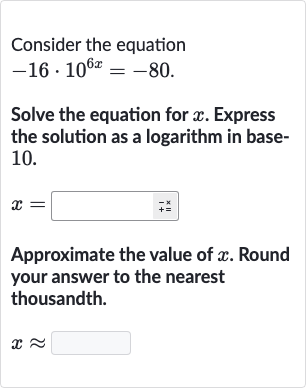Full solution
Q. Consider the equationSolve the equation for . Express the solution as a logarithm in base.Approximate the value of . Round your answer to the nearest thousandth.
- Isolate exponential term: First, let's isolate the exponential term by dividing both sides by -16").\(\newline\$-16\cdot10^{(6x)} = -80\)\(\newline\)\(10^{(6x)} = \frac{-80}{-16}\)\(\newline\)\(10^{(6x)} = 5\)
- Take logarithm: Now, we'll take the logarithm of both sides to solve for \(6x\).\[\log(10^{6x}) = \log(5)\]\[6x = \log(5)\]
- Divide by \(6\): Next, we divide both sides by \(6\) to solve for \(x\).\[x = \frac{\log(5)}{6}\]
- Calculate approximate value: Finally, we'll use a calculator to approximate the value of \(x\).\(\newline\)\(x \approx \log(5) / 6\)\(\newline\)\(x \approx 0.1139\) (rounded to the nearest thousandth)
More problems from Compare linear and exponential growth
QuestionGet tutor help
QuestionGet tutor help
QuestionGet tutor help
QuestionGet tutor help
QuestionGet tutor help
QuestionGet tutor help
QuestionGet tutor help

